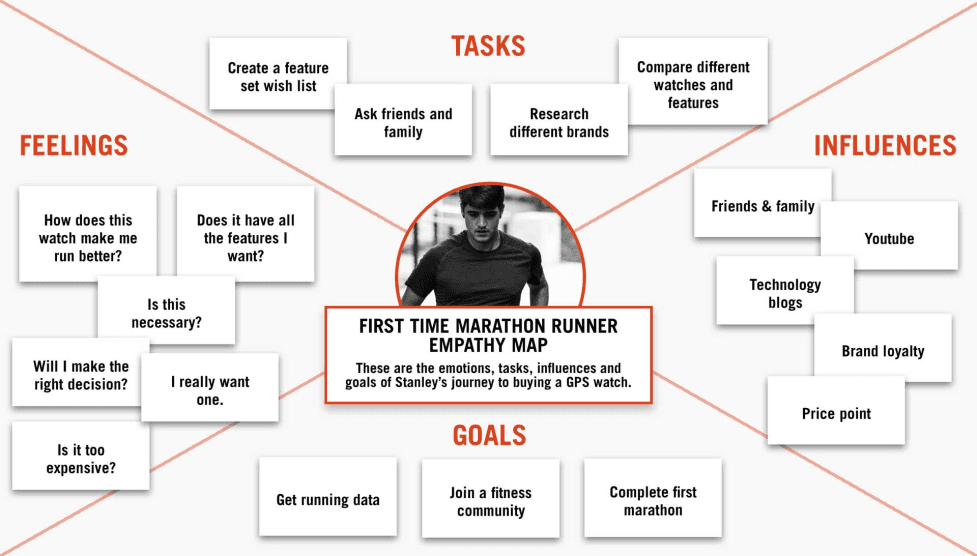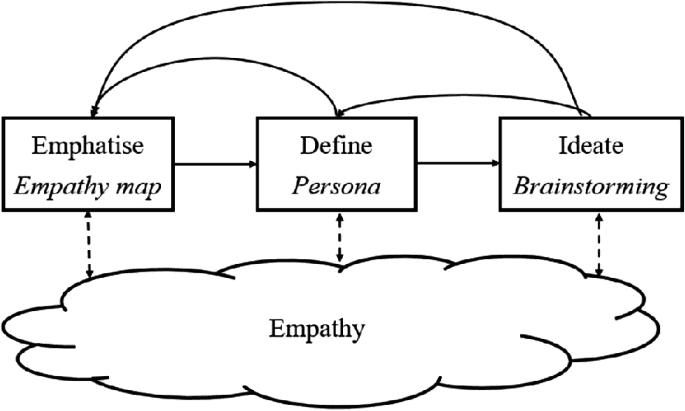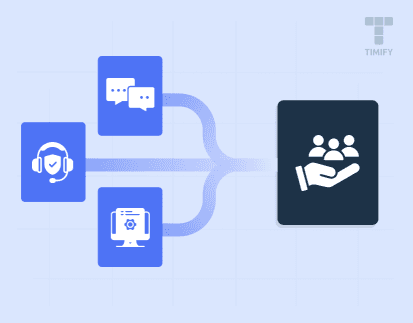

Ryan Yee
Ryan is an award-winning copywriter, with 20+ years of experience working alongside major US brands, emerging start-ups, and leading tech enterprises
Put simply, you want your business to be successful and make profits. You will employ various tactics to achieve this, from marketing strategies to a fully optimized website. But any successful strategy should start with your customers. Understanding their needs and desires and listening to their complaints can make you stand out from your competitors.
Part of understanding your customers comes from the ability to show empathy with them. You may have used buyer personas as part of your understanding but an empathy map can add to that.
What is the Purpose of the Customer Empathy Map?

An empathy map can help you fully understand your customers and use that understanding to improve customer engagement. It enables you to know how they think, what they’re feeling, and how they typically behave. With most empathy maps, you will find that there are four quadrants:
- Think and feel
- See
- Say and do
- Hear
Before you create an empathy map, you usually need some form of user persona to base it on. Most organizations use two methods to create a persona.
1. Description
With this method, you describe the persona of your customer. For example, you could have confident customers who know exactly what they want and will usually head straight to the landing page for a service or a product such as call monitoring solutions. Using the description method, you can better understand the motivation behind their actions and target them with marketing.
2. Specific person
This is the method that businesses use to create an empathy map. Rather than just describing their motivation and behavior, you actually “create” a person. You will give each person attributes such as name, gender, age — along with personal preferences about likes and dislikes. By creating a “real” person, it makes it easier for you to show empathy with them.
Who Would Use a Customer Empathy Map?
Not every member of your workforce needs to use an empathy map. Each map includes specific uses that can help different teams achieve their goals more efficiently. When it comes to empathy mapping, it should involve all relevant staff so that they build a common persona (or personas) that help them streamline tasks and collaborate (using remote PC access if needed). In particular, there are three main areas where empathy mapping can help.
1. Marketing
Empathy mapping can help your marketing teams tweak and improve their strategies by better understanding what the customers want and where they may experience issues or pain points.
2. Development
Let's say that your teams are developing an automatic call distribution solution. By including empathy mapping in their work, they gain deeper insights into crucial aspects of customer needs such as UI (user interface) and UX (user experience).
3. Product Design
If you have teams working on new products for you to sell, then empathy mapping helps make sure that the designers always keep your customers’ needs and desires center stage.
How to Build an Empathy Map

In addition to understanding customer preferences, utilizing an empathy map is akin to constructing a flowchart that guides you through the process of collecting and organizing the necessary data for each quadrant, helping you gain a comprehensive understanding of your customers' thoughts, emotions, and behaviors.
Now you can see the potential benefits of including empathy mapping in your tactics to better understand your customers. But how do you go about actually building one? You know that you need a “specific persona” to start, but what else?
1. Clearly Defined Goals
You need a clear understanding of what you're trying to achieve. Although your overall goal is to better understand your customers, each empathy map should have a more specific purpose. You may also have a common goal of making your ecommerce startup stand out, but how will empathy maps help?
In that example, you could use empathy mapping to gain insights into what a particular age demographic really wants in a product. You could also use it to identify where your current product offerings fall short of those wants. Both of those pieces of information collated from your empathy map might help to identify ways you could improve your current product(s).
2. Become the User
An empathy map should explain why customers behave a certain way. Be sure to work on gathering data for the four quadrants of an empathy map.
- Think and feel. What makes your customers think or feel the way they do? For example, someone might be very environmentally conscious and this will result in a preference for green products.
- See. What influences their purchasing decisions? This could be something as simple as age and location or it might be more complicated and can include personality factors or even the type of advertising that catches their eye.
- Say and do. This quadrant can involve some interaction with your customer base. You might interview customers to see how they feel about certain things and how they express themselves. You could even conduct surveys or listen in on calls made to your contact center or customer service team.
- Hear. What do your customers “listen” to before making a decision? What are the factors that influence that decision? For example, someone with a family might want to look at what safety features exist in a new car they want to buy.
3. Get Inside Their Mind

You’ve collected various data on your customers, some of it historical and other data from observing their behavior. Of course, you can never know exactly what they’re thinking but the data you have can help you make an informed guess. You also have to be able to understand how some emotions are linked.
Thinking — or overthinking — can affect how customers feel. If they think too much about whether a product will suit them, they can end up feeling hesitant about making a decision. Being able to understand how customers might feel can help you change tactics to nurture them. When you observe that decision hesitancy, you can think about providing more information that can overcome any decision paralysis.
4. Examine and Reflect
Once you have your completed empathy map(s), it’s time to look at the bigger picture. Brainstorm with other team members (and other pertinent teams) and reflect on the exercise you’ve just finished. Does your empathy map actually give you insights you didn’t have before and does it enable you to come up with new ideas or tactics?
You may notice from empathy mapping that a lot of your customers show a preference for eco-friendly products. That insight can then allow your marketing team to emphasize your green credentials or your design and development teams to work on new products or services that meet your customers’ needs. Retain any empathy maps you make for all relevant teams to access and reference in future exercises.
The Takeaway

No matter what industry you’re in, your customers should be at the core of your business. Creating a customer empathy map will be key to understanding what makes them happy.
Marketing, development, and product design teams can all benefit from a customer empathy map. You can use it to lay out relevant quadrants and tap into your customers’ thoughts, feelings, emotions, and behavior.
However, not all maps are created equal. You learned the critical steps to building an effective one.
The secret is to focus on your customer persona. You then need to clearly define your goals and step into the consumers’ shoes (and heads) to understand how emotions and actions are linked. Finally, as with any process, you need to assess whether your mapping strategy is working and tweak it where necessary.
Follow these steps and you’ll have a genuine understanding of what makes your customers tick.

About the author
Ryan Yee
Ryan is an award-winning copywriter, with 20+ years of experience working alongside major US brands, emerging start-ups, and leading tech enterprises. His copy and creative have helped companies in the B2B marketing, education, and software sectors reach new customer bases and enjoy improved results. Here is his LinkedIn.
Related articles


